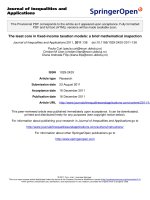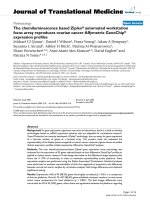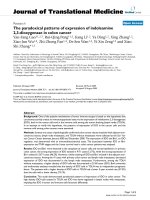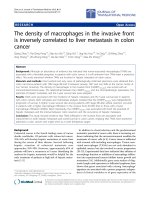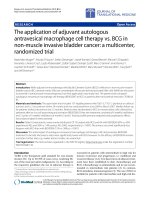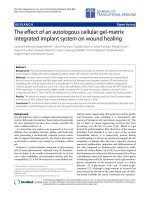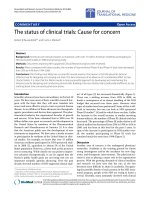báo cáo hóa học:" The AMC Linear Disability Score (ALDS): a cross-sectional study with a new generic instrument to measure disability applied to patients with peripheral arterial diseas" potx
Bạn đang xem bản rút gọn của tài liệu. Xem và tải ngay bản đầy đủ của tài liệu tại đây (258.2 KB, 8 trang )
BioMed Central
Page 1 of 8
(page number not for citation purposes)
Health and Quality of Life Outcomes
Open Access
Research
The AMC Linear Disability Score (ALDS): a cross-sectional study
with a new generic instrument to measure disability applied to
patients with peripheral arterial disease
Rosemarie Met
1
, Jim A Reekers*
1
, Mark JW Koelemay
2
, Dink A Legemate
2
and Rob J de Haan
3
Address:
1
Department of Radiology, Academic Medical Center, Meibergdreef 9, 1105 AZ, Amsterdam, the Netherlands,
2
Department of Vascular
Surgery, Academic Medical Center, Meibergdreef 9, 1105 AZ, Amsterdam, the Netherlands and
3
Department of Clinical Epidemiology and
Biostatistics, Academic Medical Center, Meibergdreef 9, 1105 AZ, Amsterdam, the Netherlands
Email: Rosemarie Met - ; Jim A Reekers* - ; Mark JW Koelemay - ;
Dink A Legemate - ; Rob J de Haan -
* Corresponding author
Abstract
Background: The AMC Linear Disability Score (ALDS) is a calibrated generic itembank to
measure the level of physical disability in patients with chronic diseases. The ALDS has already been
validated in different patient populations suffering from chronic diseases. The aim of this study was
to assess the clinimetric properties of the ALDS in patients with peripheral arterial disease.
Methods: Patients with intermittent claudication (IC) and critical limb ischemia (CLI) presenting
from January 2007 through November 2007 were included. Risk factors for atherosclerosis, ankle/
brachial index and toe pressure, the Vascular Quality of Life Questionnaire (VascuQol), and the
ALDS were recorded. To compare ALDS and VascuQol scores between the two patient groups,
an unpaired t-test was used. Correlations were determined between VascuQol, ALDS and
pressure measurements.
Results: Sixty-two patients were included (44 male, mean ± sd age was 68 ± 11 years) with IC (n
= 26) and CLI (n = 36). The average ALDS was significantly higher in patients with IC (80, ± 10)
compared to patients with CLI (64, ± 18). Internal reliability consistency of the ALDS expressed as
Cronbach's α coefficient was excellent (α > 0.90). There was a strong convergent correlation
between the ALDS and the disability related Activity domain of the VascuQol (r = 0.64).
Conclusion: The ALDS is a promising clinimetric instrument to measure disability in patients with
various stages of peripheral arterial disease.
Background
The impact of a disease on a patient's quality of life and
level of activities of daily life (ADL) is an important out-
come measure in clinical studies [1]. It is well known that
perceived quality of life and ADL are significantly
impaired in individuals with peripheral arterial disease
(PAD) [2-5].
There are several instruments available to measure quality
of life in patients with PAD. Both generic instruments,
Published: 12 October 2009
Health and Quality of Life Outcomes 2009, 7:88 doi:10.1186/1477-7525-7-88
Received: 7 April 2009
Accepted: 12 October 2009
This article is available from: />© 2009 Met et al; licensee BioMed Central Ltd.
This is an Open Access article distributed under the terms of the Creative Commons Attribution License ( />),
which permits unrestricted use, distribution, and reproduction in any medium, provided the original work is properly cited.
Health and Quality of Life Outcomes 2009, 7:88 />Page 2 of 8
(page number not for citation purposes)
such as the Short-Form 36 (SF36), the Sickness Impact
Profile, and the Nottingham Health Profile [6], and dis-
ease-specific instruments like the Vascular Quality of Life
Questionnaire (VascuQol) and the Claudication Scale
(CLAU-S) are frequently used [7,8]. A limitation of these
instruments is that they do not focus on level of ADL in
terms of self-care, dressing, indoors and outdoors activi-
ties, and housekeeping management. Measuring this level
of disability is useful, since it is more closely related to
impairments and the course of the disease itself. Within
the field of PAD, however, there are no instruments avail-
able which specifically address the patient's level of ADL.
The AMC (Academic Medical Center) Linear Disability
Score (ALDS) is a recently developed generic itembank
which measures disability, as expressed by the ability to
perform ADL [9,10]. In contrast to the widely used sum
score-based questionnaires, the ALDS itembank was
developed within the flexible framework of the item-
response theory (IRT). The ALDS has already been vali-
dated in a large, mixed patient population [11] and in
patients suffering from rheumatoid arthritis, stroke and
Parkinson's disease [12-14]. The objective of this study
was to evaluate the clinimetric properties of the ALDS in
patients with different stages of PAD.
Methods
Patients
A convenient sample of 62 patients was included in this
prospective study. We deliberately selected patients with
different stages of disease to evaluate the ALDS for the
whole spectrum of PAD. Patients visited the vascular lab-
oratory or vascular nursing ward of our hospital between
January 2007 and November 2007. All patients were diag-
nosed with either intermittent claudication (IC; Ruther-
ford category 1, 2 or 3) or chronic critical limb ischemia
(CLI; Rutherford category 4, 5 or 6) [15]. The clinical diag-
nosis was confirmed by perfusion parameters, such as
ankle/brachial index (ABI) and toepressure (TP). Patients
were assessed and interviewed by one of the authors
(RM). Assessments took place before intervention, con-
sisting of exercise training, revascularization or amputa-
tion. The study was approved by the local Institutional
Review Board.
Assessments
We recorded risk factors for atherosclerosis, namely diabe-
tes mellitus, hypertension, smoking, renal failure, hyperc-
holesterolemia, history of coronary artery disease or
cerebrovascular disease. In patients with IC, we measured
ABI at rest and after exercise. In patients with CLI, we
measured ABI at rest and TP.
Quality of life was measured using the VascuQol, which is
a sum-score based instrument. The questionnaire consists
of 25 items on five domains, i.e. Pain (4 items), Activity
(8), Emotional (7), Symptoms (4) and Social (2). Each
item is rated as a seven point response scale, with a score
of one being the worst and a score of seven the best possi-
ble. The total average score is the sum of all 25 items
scores divided by 25. For each separate domain an average
score can be calculated (sum of all items of one domain
divided by the number of items of that domain). So, both
the overall score as well as the scores per domain range
from one to seven [16]. The VascuQol has shown to be a
reliable and valid instrument for assessment of QoL in
patients with PAD [7,17].
Disability status was evaluated using the ALDS. For the
psychometrical details of IRT in relation to the ALDS, see
Additional file 1. The current version of the ALDS item-
bank consists of 77 items, ranging from very easy (e.g., get
out of bed into a chair) to relatively difficult (e.g., walk for
more than 15 minutes) [see Additional file 2]. Initially,
the ALDS was developed within a dichotomous IRT
model with two response options 'I can carry out the activ-
ity' and 'I cannot carry out the activity' [9]. However, the
dichotomous rating scales were disliked by some respond-
ents as they are perceived as too restrictive. Therefore, the
option 'with difficulty' has been added. Currently, each
item has three response options, but the response options
'can carry out' and 'can carry out, but with difficulty' are
analysed as one response category. In the case that a
patient has never performed the activity or answers that he
does not know, 'Not applicable' is recorded. The original
units of the ALDS scale are (logistic) regression coeffi-
cients, expressed in logits. To make the results easier to
interpret these scores are linearly transformed into values
between 0 and 100. Lower scores represent more disabil-
ity.
A major strength of an IRT itembank is that researchers,
using their clinical judgment, can make their own selec-
tions of items from the itembank that are applicable to the
population they are investigating. By using a small
number of items tailored to the expected ADL level of
patients, a detailed clinical picture can be obtained with-
out the need to have all the questions answered by the
patient. Even if different sets of items are used for different
patient groups, ALDS scores can still be compared because
all items are derived from the calibrated itembank. In this
way the ALDS can be used to assess patients with a wide
range of conditions and levels of functional status.
The methodology [9], the psychometrics of the ALDS in
terms of dealing with missing data [18], differences
between item measurement characteristics of the item-
bank in relation to age and sex [19] and the metric prop-
erties of ALDS items in mixed types of patient groups [11-
14], as well as the statistical power to detect given effect
Health and Quality of Life Outcomes 2009, 7:88 />Page 3 of 8
(page number not for citation purposes)
sizes in clinical trials using IRT outcome scales [20] have
been examined in depth.
From the ALDS itembank, two questionnaires were com-
posed in this study: one questionnaire for claudicants (29
items), and one questionnaire for patients with critical
limb ischemia (27 items). Twenty-three items were in
common, covering the whole range of the ALDS item-
bank. Besides these common items, the claudication ques-
tionnaire encompassed six additional, relatively more
difficult activities, whereas in the critical limb ischemia
questionnaire four extra, relatively easier activities were
offered. Selecting a representative range of items is essen-
tial to prevent floor and ceiling effects. For example, pre-
senting a slightly disabled patient only items between an
ALDS of 10 to 50, the maximum achieved ALDS will be 50
(ceiling effect), whereas with items ranging from 0
through 100, the 'real score' (for example 80) can be
achieved. Since the ALDS is based on the IRT, the score is
not influenced by the selected items [9]. For the complete
ALDS item bank and the selected items in this study, see
Additional file 2.
Clinimetric evaluation
The clinical measurement properties of the ALDS were
evaluated in terms of internal consistency reliability, con-
struct validity and clinical validity.
Internal consistency reliability refers to the statistical
coherence of the scale items. One measure of internal con-
sistency is the Cronbach's α coefficient, which is based on
the (weighted) average correlation of items within a scale
[21,22]. Internal consistency is considered to be good if α
≥ 0.80 [23]. We also calculated item-total correlations
which represent the correlation of a single item with the
sum of all other items. Correlations ≥ 0.40 were conserv-
atively considered to be sufficient.
Construct validity concerns whether the new scale corre-
sponds with other instruments measuring the same health
concept and instruments measuring different aspects of
health. We assumed that in order for the ALDS to be valid,
the ALDS scores had to show a decreasing pattern of asso-
ciations, with the highest correlation with the disability
related Activity domain of the VascuQol, intermediate
correlations with the VascuQol subscales Symptom, Pain,
Emotional and Social, and the lowest with the impair-
ments in terms of ABI and TP [24,25].
Clinical validity (also known as known-groups validity)
refers to the ability of an instrument to discriminate
between patient groups with known differences in clinical
status. In this study, clinical validity was investigated by
comparing the ALDS between patients with IC and
patients with CLI, with ALDS scores to be expected higher
in patients with IC than in patients with CLI.
The VascuQol was used as benchmark and therefore the
analyses focusing the association between functional
health and the vascular parameters and the mean score
differences between patients with IC and CLI, were also
done for the VascuQol and its Activity domain.
Statistical analysis
Patient characteristics and outcome scores were summa-
rized using descriptive statistics. Distribution of the data
was tested with a histogram and the Kolmogorov-Smirnov
test. In case of discrepancy between both methods, we
regarded the data as not normally distributed. ALDS out-
come scores were calculated using a dichotomous IRT
model, based on previously published item properties
[11] and algorithms implemented in BILOG-MG (version
3.0) and SPSS version 14.0 (SPSS Inc, Chicago, Illinois).
In this approach the response options 'can carry out' and
'can carry out, but with difficulty' are analysed as one
response category. ALDS items which were rated 'Not
applicable' were statistically considered as if they were not
presented to that patient [18].
Cronbach's α was obtained using a specific IRT method
that allows for missing item responses. The average item-
total correlation was calculated using a biserial correla-
tion. Associations between the ALDS (and VascuQol) and
other outcome measures were expressed in Pearsons's or
Spearman's correlation coefficients, when appropriate.
We labelled the strength of the association: correlation
coefficients r = 0.00-0.19 were regarded as very weak, r =
0.20-0.39 as weak, r = 0.40-0.59 as moderate, r = 0.60-
0.79 as strong and r = 0.80-1.00 as very strong [26]. An
unpaired t-test was used to compare ALDS and VascuQol
scores between the two patients groups. Difference in
mean scores between both diagnosis groups was
expressed in Cohen's d effect size, defined as the difference
between the means divided by the pooled standard devia-
tion. An effect size value between 0.50 and 0.80 is consid-
ered as a moderate difference, and ≥ 0.80 as substantial
[27].
Results
A total of 62 patients were included, 26 (42%) with inter-
mittent claudication (Rutherford 1 in 6 patients, Ruther-
ford 2 in 13, and Rutherford 3 in 7 patients) and 36 (58%)
with critical limb ischemia (Rutherford 4 in 11 patients,
Rutherford 5 in 17, and Rutherford 6 in 8 patients). The
majority of the patients (71%) were male and the mean
age was 68 (± 11) years. Table 1 shows the patient charac-
teristics at time of assessment. The VascuQol Total score,
the VascuQol domains Activity, Symptoms, Pain, Emo-
tional and Social, and the ALDS were all normally distrib-
Health and Quality of Life Outcomes 2009, 7:88 />Page 4 of 8
(page number not for citation purposes)
uted (histograms showed normal distribution and
Kolmogorov-Smirnov test p-values > 0.10). The decrease
in ABI, resting ABI, and TP were considered not normally
distributed (although the Kolmogorov-Smirnov test had a
p-value > 0.05, the histograms did not show a Gaussian
distribution).
Table 1: Patient characteristics (n = 62) at assessment.
Characteristics Mean (± sd) or median (range) or n (%)
Gender, male 44 (71%)
Age 68.4 (± 11.4)
Risk factors
Diabetes mellitus 22 (35%)
Hypertension 44 (71%)
Current or former smoker 51 (82%)
Renal failure 16 (26%)
Hypercholesterolemia 15 (24%)
History of coronary artery disease 23 (37%)
History of stroke 12 (19%)
Fontaine stage
II; intermittent claudication 26 (42%)
III or IV; critical limb ischemia 36 (58%)
Definitive treatment
Conservative 15 (24%)
Endovascular revascularization 36 (58%))
Surgical revascularization 8 (13%)
Amputation 3 (5%)
ABI at rest
(in patients with CLI)
0.35 (0-0.59)
Decrease ABI after exercise
(in patients with IC)
a
0.28 (0.09-0.55)
Toe pressure mmHg
(in patients with CLI)
19 (0-67)
ALDS 71 (± 17)
VascuQol total 3.7 (± 1.3)
a
Indicates difference in ABI before and after exercise
Health and Quality of Life Outcomes 2009, 7:88 />Page 5 of 8
(page number not for citation purposes)
The internal consistency reliability of the ALDS in terms of
Cronbach's α and item-total correlation turned out to be
good; α coefficient > 0.90, average item-total correlation:
0.75.
Table 2 presents the correlations between the ALDS scores
and the various subscale scores of the VascuQol. Conver-
gent validity was confirmed with a relatively strong corre-
lation (r = 0.64) between the ALDS and the disability
related Activity domain of the VascuQol. Moderate corre-
lations were observed between the ALDS and the sub-
scales Symptom (r = 0.44) and Social (r = 0.52), whereas
the ALDS was weakly associated with the Emotional and
Pain domains (0.30 and 0.28). Table 3 presents the corre-
lations between the ALDS and the VascuQol scores on the
one hand and decrease in ABI, resting ABI, and TP. These
correlations were (very) weak (r range: 0 - 0.38).
Clinical validity is shown in Table 4. The ALDS score was
significantly higher in patients with claudication (ALDS
score 80) than in patients with CLI (ALDS score 64). Sim-
ilar results were obtained for the VascuQol total score (4.5
in patients with claudication and 3.1 in patients with CLI)
and the VascuQol domain Activity (4.0 in patients with
claudication versus 2.4 in patients with CLI). The effect
size values for the ALDS and the VascuQol total and sub-
scale scores were d = 0.97, 1.13, and 1.08, respectively.
Discussion
In this study, we showed that the ALDS has promising
clinical measurement properties to assess the level of dis-
ability in patients with PAD. The ALDS demonstrated con-
vincing statistical coherence and was higher in patients
with milder disease, who are expected to be less disabled.
We could not compare the ALDS with a gold standard, as
there is not such an instrument measuring disability avail-
able for patients with PAD. A recent study, comparing
three questionnaires - two generic questionnaires (the
EuroQol and SF-36) and one disease-specific question-
naire (the VascuQol) - showed that the VascuQol is the
preferred questionnaire for measuring QoL in patients
with PAD [7]. For this reason, we used the VascuQol, and
especially its Activity domain, as benchmark for the ALDS
analyses. Construct validity was confirmed by a relatively
strong association of the ALDS with the domain Activity
of the VascuQol, which also measures aspects of physical
disability. Construct validity was further supported by
decreasing correlations with the other non-disability
domains of the VascuQol and the clinical indicators of
lower limb ischemia.
The weak correlation between the ALDS (and VascuQol)
and clinical indicators of lower limb perfusion in terms of
ABI and toe pressure may seem remarkable, but is in line
with previous studies in other populations showing that
objective disease indicators are not always clearly reflected
in (subjective) aspects of functional health [28]. This
seems to be true also for patients with PAD. Long et al did
not find a correlation between the ABI, the Walking
Impairment Questionnaire (WIQ, measuring mobility)
and the Physical Component score of the SF36 in patients
with symptoms of PAD [24]. Other studies also failed to
demonstrate a correlation between the ABI and the SF36
Physical functioning domain and the EuroQol [25,29,30].
The WIQ [31,32] is one of the few instruments that
assesses the level of disability in terms of mobility. This
questionnaire focuses mainly on walking ability, divided
in four subcategories: pain, distance, walking speed and
stair climbing. The WIQ has been developed specifically
for patients with IC, and does not cover the whole spec-
trum of PAD. The ALDS carries the advantage that it can
be used for both patients with IC and CLI. Moreover, the
ALDS focuses on the whole spectrum of basic and com-
plex activities of daily life, including self-care, different
mobility levels, housekeeping and outdoor activities.
Most clinicians are used to work with traditional outcome
instruments based on sum scores. Although adding up
individual item scores to a total score is comprehensibly
in use, several problems are associated with this approach.
Firstly, all items of the questionnaire have to be presented
to patients in order to obtain a summated score. This
implies that for a detailed picture of the patient, a long
questionnaire encompassing many questions, is needed,
increasing patient burden and research effort. This ineffi-
ciency has led researchers to shorten health measurement
instruments, resulting in less precise scales. Secondly, the
ordinal nature of summated scores implies that a given
difference in scores at one point on the scale does not nec-
essarily represent the same amount of functional change
as an identical difference at another point on the scale.
Following growing dissatisfaction with this 'classical'
Table 2: Construct validity; Pearson's correlation coefficients
between the ALDS and the VascuQol (n = 62).
ALDS
VascuQol; Total score r = 0.55 p = < 0.001
VascuQol; domain Activity r = 0.64 p = < 0.001
VascuQol; domain Symptoms r = 0.44 p = < 0.001
VascuQol; domain Pain r = 0.28 p = 0.03
VascuQol; domain Emotional r = 0.30 p = 0.02
VascuQol; domain Social r = 0.52 p = < 0.001
Health and Quality of Life Outcomes 2009, 7:88 />Page 6 of 8
(page number not for citation purposes)
approach, IRT has been introduced to overcome these
methodological problems [33].
Measurement instruments based on the IRT have some
specific advantages. A clinician can select a set of items
which is applicable to the population that is investigated,
not all items from the itembank are needed to obtain a
score. For example, very easy items do not have to be pre-
sented to minor disabled patients. Therefore, the ALDS
can be administered in a time-efficient way (in this study
between 5-10 minutes). There are some essential aspects
to be aware of. As mentioned before, to prevent floor and
ceiling effects (i.e. the extent to which respondents score
at the bottom or top of a scale) it is very important to ask
a patient activities he is able to do and also activities he is
not able to do, instead of asking too difficult or too easy
questions. If one does so, it does not matter which ques-
tions are picked to assess patient's disability level, since
the ALDS is based on the IRT. The latter is, as we found
out, the most difficult part of the ALDS to appreciate by
those who are used to work with the traditional question-
naires.
Some limitations of this study should be recognized. A
repeated measurement with an instrument in the same
patient or using different interviewers must give more or
less the same outcome in the case of an unchanged
patient. In the present study, we did not analyze test-retest
or between-interviewer reliability. Yet, in a previous study
with the ALDS in patients with rheumatoid arthritis, excel-
lent test-retest reliability was found with an Intra Class
Coefficient of 0.93 [14]. Other disadvantages are that the
ALDS interviewer was not blinded to patient characteris-
tics and that we studied a relatively small number of
patients. This must be taking into account when interpret-
ing the results.
As the objective of this validation study was to investigate
the measurement properties of ALDS in patients with dif-
ferent stages of PAD, we deliberately selected patients for
inclusion, instead of consecutive enrolment, to guarantee
that the whole spectrum of PAD was represented in our
sample. There is no reason to assume that this non-con-
secutive inclusion has influenced our psychometrical
findings.
Conclusion
Our study must be seen as a first step in the process of val-
idation of the ALDS in patients with PAD. Further evalua-
tion of this instrument, especially with regard to the test-
retest and between-reviewer reliability and the presence of
floor and ceiling effects, is needed in a larger consecutive
patient population. We think the instrument could be
particularly useful in research, to measure the effect of
treatment. Before this, the responsiveness of the ALDS to
health change over time must be investigated. In conclu-
Table 3: Construct validity; Spearman correlation coefficients between the ALDS, the VascuQol and clinical indicators (n = 62).
ALDS VascuQol
(Activity)
VascuQol
(Total)
Decrease ABI after exercise
(in patients with IC)
r = 0.16 p = 0.50 r = 0.00 p = 1.00 r = 0.16 p = 0.50
ABI at rest
(in patients with CLI)
r = 0.14 p = 0.49 r = 0.02 p = 0.92 r = 0.20 p = 0.33
Toe pressure
(in patients with CLI)
r = 0.19 p = 0.37 r = 0.38 p = 0.06 r = 0.18 p = 0.38
Table 4: Clinical validity: ALDS and VascuQol score of patients with IC (n = 26) and CLI (n = 36).
Patient groups
Intermittent claudication Critical limb ischemia Difference
(95% confidence interval)
ALDS 80 (± 10) 64 (± 18) 16 (8-24) p < .001
a
d = 0.97
VascuQol (Activity) 4.0 (± 1.6) 2.4 (± 1.1) 1.7 (0.9-2.4) p < .001
a
d = 1.08
VascuQol (Total) 4.5 (± 1.1) 3.1 (± 1.0) 1.4 (0.9-2.0) p < .001
a
d = 1.13
a
Unpaired t-test; d = Cohen's effect size
Health and Quality of Life Outcomes 2009, 7:88 />Page 7 of 8
(page number not for citation purposes)
sion, the results of this pilot study show that the ALDS has
promising metric properties and is a potentially useful
tool to measure activities of daily life in patients with
PAD.
Abbreviations
ABI: Ankle/brachial index; ADL: Activities of daily life;
ALDS: AMC Linear Disability Score; AMC: Academic Med-
ical Center; CLAU-S: Claudication Scale; CLI: Critical limb
ischemia; IC: Intermittent claudication; IRT: Item
response theory; PAD: Peripheral arterial disease; SD:
Standard deviation; SF36: Short-Form 36; TP: Toe pres-
sure; VascuQol: Vascular Quality of Life Questionnaire;
WIQ: Walking impairment questionnaire.
Competing interests
The authors declare that they have no competing interests.
Authors' contributions
RM has made substantial contributions to design of the
study and acquisition and analysis of data, and drafting of
the manuscript, JAR has been involved in the design of the
study and interpretation of data, as well as in drafting the
manuscript, MJWK was involved in interpretation of data
and drafting the manuscript, DAL contributed to the
design and revised the manuscript critically, RJH was
involved in design, analysis and interpretation of the data
and drafting of the manuscript. All authors read and
approved the final manuscript.
Additional material
Acknowledgements
None.
References
1. World Health Organization: International Classification of Func-
tioning, Disability, and Health. [ />plate.cfm].
2. Regensteiner JG, Hiatt WR, Coll JR, Criqui MH, Treat-Jacobson D,
McDermott MM, Hirsch AT: The impact of peripheral arterial
disease on health-related quality of life in the Peripheral
Arterial Disease Awareness, Risk, and Treatment: New
Resources for Survival (PARTNERS) Program. Vasc Med
2008, 13:15-24.
3. McDermott MM, Mehta S, Liu K, Guralnik JM, Martin GJ, Criqui MH,
Greenland P: Leg symptoms, the ankle-brachial index, and
walking ability in patients with peripheral arterial disease. J
Gen Intern Med 1999, 14:173-181.
4. Brach JS, Solomon C, Naydeck BL, Sutton-Tyrrell K, Enright PL, Jenny
NS, Chaves PM, Newman AB, Cardiovascular Health Study Research
Group: Incident physical disability in people with lower
extremity peripheral arterial disease: the role of cardiovas-
cular disease. J Am Geriatr Soc 2008, 56:1037-1044.
5. Kuo HK, Yu YH: The relation of peripheral arterial disease to
leg force, gait speed, and functional dependence among
older adults. J Gerontol A Biol Sci Med Sci 2008, 63:384-390.
6. Landry GJ: Functional outcome of critical limb ischemia. J Vasc
Surg 2007, 45:141a-148a.
7. De Vries M, Ouwendijk R, Kessels AG, De Haan MW, Flobbe K, Hun-
ink MG, Van Engelshoven JM, Nelemans PJ: Comparison of generic
and disease-specific questionnaires for the assessment of
quality of life in patients with peripheral arterial disease. J
Vasc Surg 2005, 41:261-268.
8. Mehta T, Venkata Subramaniam A, Chetter I, McCollum P: Disease-
specific quality of life assessment in intermittent claudica-
tion: review. Eur J Vasc Endovasc Surg 2003, 25:202-8.
9. Holman R, Lindeboom R, Glas CA, Vermeulen M, De Haan RJ: Con-
structing an item bank using item response theory: the AMC
Linear Disability Score project. Health Serv Outcomes Res Meth-
odol 2003, 4:19-33.
10. De Haan RJ, Vermeulen M, Holman R, Lindeboom R: Measuring the
functional status of patients in clinical trials using modern
clinimetric methods [Dutch]. Ned Tijdschr Geneeskd 2002,
146:606-611.
11. Holman R, Weisscher N, Glas CA, Dijkgraaf MG, Vermeulen M, De
Haan RJ, Lindeboom R: The Academic Medical Center Linear
Disability Score (ALDS) item bank: item response theory
analysis in a mixed patient population. Health Qual Life Out-
comes 2005, 3:83.
12. Weisscher N, Wijbrandts CA, De Haan R, Glas CA, Vermeulen M,
Tak PP: The Academic Medical Center Linear Disability
Score item bank: psychometric properties of a new generic
disability measure in rheumatoid arthritis. J Rheumatol 2007,
34:1222-1228.
13. Weisscher N, Vermeulen M, Glas CA, Roos YB, De Haan RJ: The
AMC Linear Disability Score itembank: a new generic disa-
bility measure in stroke. 2008:81-92 [ />270674]. Thesis: The AMC Linear Disability Score (ALDS): Measuring
disability in clinical studies. Amsterdam
14. Weisscher N, Post B, De Haan RJ, Glas CA, Speelman JD, Vermeulen
M: The AMC linear disability score in patients with newly
diagnosed Parkinson disease. Neurology 2007, 69:2155-2161.
15. Rutherford RB, Baker JD, Ernst C, Johnston KW, Porter JM, Ahn S,
Jones DN: Recommended standards for reports dealing with
lower extremity ischemia: revised version. J Vasc Surg 1997,
26:517-538.
16. Morgan MB, Crayford T, Murrin B, Fraser SC: Developing the Vas-
cular Quality of Life Questionnaire: a new disease-specific
quality of life measure for use in lower limb ischemia. J Vasc
Surg 2001, 33:679-687.
17. Nguyen LL, Moneta GL, Conte MS, Bandyk DF, Clowes AW, Seely BL:
Prospective multicenter study of quality of life before and
after lower extremity vein bypass in 1404 patients with crit-
ical limb ischemia. J Vasc Surg 2006, 44:977-983.
18. Holman R, Glas CA: Modelling non-ignorable missing data
mechanisms with item response theory models. Br J Math Stat
Psychol 2005, 58:1-17.
19. Holman R, Lindeboom R, De Haan RJ: Gender and age based dif-
ferential item functioning in the AMC Linear Disability Score
project. Quality of life newsletter 2004, 32:1-4.
20. Holman R, Glas CA, De Haan RJ: Power analysis in randomized
clinical trials based on item response theory. Control Clin Trials
2003, 24:390-410.
21. Cronbach LJ: Coefficient alpha and the internal structure of
tests. Psychometrika 1951, 16:297-333.
22. Bland JM, Altman DG: Cronbach's alpha. BMJ 1997, 314:572.
23. Nunnally J: Psychometric theory New York: McGraw-Hill; 1978.
Additional file 1
Methodology of the ALDS itembank. Data represent details about the
construction of the ALDS itembank.
Click here for file
[ />7525-7-88-S1.DOC]
Additional file 2
ALDS itembank containing 77 items. Data represent a list of all 77
items of the ALDS itembank, the items we used in our study are marked.
Click here for file
[ />7525-7-88-S2.DOC]
Publish with BioMed Central and every
scientist can read your work free of charge
"BioMed Central will be the most significant development for
disseminating the results of biomedical research in our lifetime."
Sir Paul Nurse, Cancer Research UK
Your research papers will be:
available free of charge to the entire biomedical community
peer reviewed and published immediately upon acceptance
cited in PubMed and archived on PubMed Central
yours — you keep the copyright
Submit your manuscript here:
/>BioMedcentral
Health and Quality of Life Outcomes 2009, 7:88 />Page 8 of 8
(page number not for citation purposes)
24. Long J, Modrall JG, Parker BJ, Swann A, Welborn MB 3rd, Anthony T:
Correlation between ankle-brachial index, symptoms, and
health-related quality of life in patients with peripheral vas-
cular disease. J Vasc Surg 2004, 39:723-727.
25. Izquierdo-Porrera AM, Gardner AW, Bradham DD, Montgomery PS,
Sorkin JD, Powell CC, Katzel LI: Relationship between objective
measures of peripheral arterial disease severity to self-
reported quality of life in older adults with intermittent clau-
dication. J Vasc Surg 2005, 41:625-630.
26. Swinscow TDV: Correlation and regression. Statistics at Square
One 9th edition. 1997 [ />]. Univer-
sity of Southampton: BMJ Publishing Group
27. Cohen J: Statistical power analysis for the behavioral sciences New York:
Academic Press; 1977.
28. Weisscher N, De Haan RJ, Vermeulen M: The impact of disease-
related impairments on disability and health-related quality
of life: a systematic review. BMC Med Res Methodol 2007, 7:24.
29. Feinglass J, McCarthy WJ, Slavensky R, Manheim LM, Martin GJ:
Effect of lower extremity blood pressure on physical func-
tioning in patients who have intermittent claudication. J Vasc
Surg 1996, 24:503-512.
30. Chetter IC, Dolan P, Spark JI, Scott DJA, Kester RC: Correlating
clinical indicators of lower-limb ischaemia with quality of life.
Cardiovasc Surg 1997, 5:361-366.
31. Regensteiner JG, Steiner JF, Panzer RJ, Hiatt WR: Evaluation of
walking impairment by questionnaire in patients with
peripheral arterial disease. J Vasc Med Biol 1990, 2:142-152.
32. McDermott MM, Liu K, Guralnik JM, Martin GJ, Criqui MH, Green-
land P: Measurement of walking endurance and walking veloc-
ity with questionnaire: validation of the walking impairment
questionnaire in men and women with peripheral arterial
disease. J Vasc Surg 1998, 28:1072-1081.
33. Linden WJ Van der, Hambleton RK: Handbook of Modern Item
Response Theory New York: Springer; 1997.

